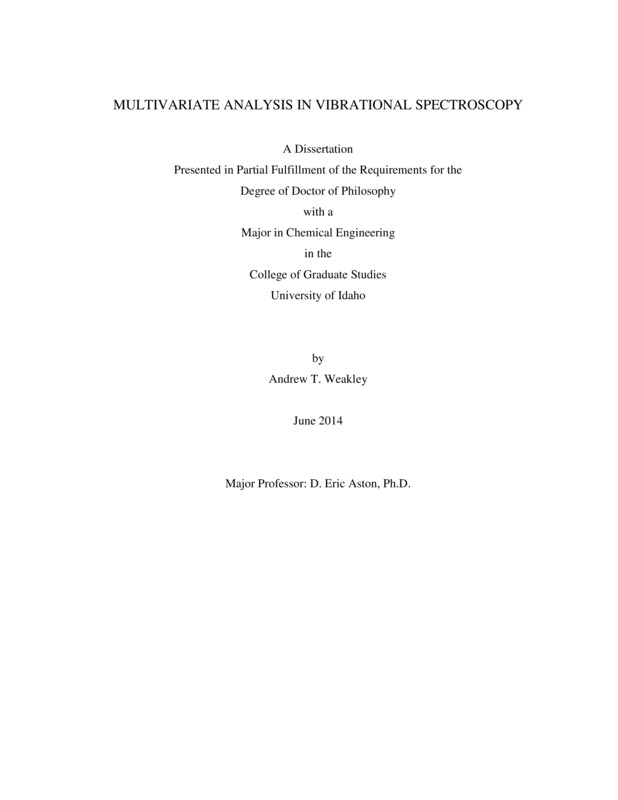MULTIVARIATE ANALYSIS IN VIBRATIONAL SPECTROSCOPY
Weakley, Andrew T.. (2014). MULTIVARIATE ANALYSIS IN VIBRATIONAL SPECTROSCOPY. Theses and Dissertations Collection, University of Idaho Library Digital Collections. https://www.lib.uidaho.edu/digital/etd/items/weakley_idaho_0089e_10295.html
- Title:
- MULTIVARIATE ANALYSIS IN VIBRATIONAL SPECTROSCOPY
- Author:
- Weakley, Andrew T.
- Date:
- 2014
- Keywords:
- Chemometrics Infrared Model Selection Raman Vibrational Spectroscopy
- Program:
- Chemical Engineering and Materials Engineering
- Subject Category:
- Chemistry; Chemical engineering; Analytical chemistry
- Abstract:
-
Multivariate analysis in vibrational spectroscopy involves the application of procedures and protocols from multivariate statistics, signal processing, and experimental design to elucidate physico-chemical phenomena studied using high-dimensional data sets acquired from multichannel instrumentation. These so-called chemometric procedures are applicable to a range of questions relevant to the practice of analytical chemistry and engineering. Formal areas such as exploratory data analysis, multivariate classification, multivariate calibration, and curve resolution are common focus areas of chemometricians. This dissertation concerns the exclusive use of latent variable models to assess analytical quantities and chemical systems via vibrational spectroscopy for the purpose of data exploration and calibration. The principal goal of this dissertation was to develop and/or innovate domains pertinent to multivariate calibrations utilizing principal component analysis (PCA), principal component regression (PCR), and/or partial least-squares (PLS) regression. Specific objectives included: developing two novel baseline correction algorithms (chapter 2 and 3) to optimally preprocess vibrational spectra prior to calibration, applying PCA and PCR to probe the specific hydrogen-bonding behavior of thermoplastic polyurethane (TPU) blends (chapter 4), utilizing a PLS regression to determined the quantity of filter-adsorbed silica from metal/non-metal mines (chapter 5), and finally developing rigorous and comprehensive model selection criteria to choose a best PLS regression among viable alternative offered by the novel application of backward Monte Carlo unimportant variable elimination (BMCUVE). Overall, those chapters exclusively focused on multivariate calibration using vibrational spectra (chapter 4-6) demonstrate that statistical and scientific validity converge under the auspices of a well-designed, chemometric analysis.
- Description:
- doctoral, Ph.D., Chemical Engineering and Materials Engineering -- University of Idaho - College of Graduate Studies, 2014
- Major Professor:
- Aston, D. E
- Committee:
- Morra, Matthew M.; Moberly, James; Utgikar, Vivek
- Defense Date:
- 2014
- Identifier:
- Weakley_idaho_0089E_10295
- Type:
- Text
- Format Original:
- Format:
- application/pdf
- Rights:
- In Copyright - Educational Use Permitted. For more information, please contact University of Idaho Library Special Collections and Archives Department at libspec@uidaho.edu.
- Standardized Rights:
- http://rightsstatements.org/vocab/InC-EDU/1.0/

